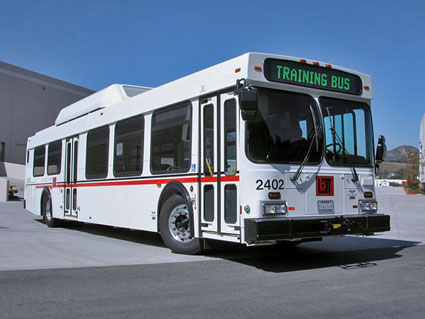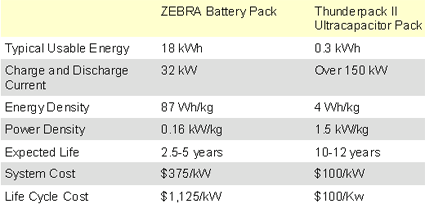Supercapacitor integration optimizes hybrid bus powertrain
The depletion of natural resources, air pollution, traffic congestion and rising fossil fuel prices have forced society and individuals to seek alternative means of transport. Among them are hybrid electric vehicles for buses and trucks, hydrogen and fuel cell-based power systems, such as those produced by ISE (San Diego, CA) since 1996. This article refers to the address: http:// These power systems are popular throughout the automotive industry because they increase fuel efficiency and reduce harmful emissions. ISE specializes in the production of series hybrid electric power systems in which the engine is completely disconnected from the powertrain and is only used to generate electricity. figure 1 This type of hybrid architecture is particularly attractive for large vehicles that perform a large number of "stop-and-go" drives, such as city transport buses and cargo trucks. Traditional buses and trucks are inefficient and produce highly harmful emissions because their large engines (usually diesel engines) continuously accelerate and decelerate the vehicle – one of the least efficient ways to generate power. In ISE's series hybrid system, the smaller engine works closely with the generator to operate at a constant, efficient speed and power output stage. When the vehicle power needs to be temporarily increased, such as during acceleration or mountain climbing, power is drawn from the energy storage system consisting of a battery and a super capacitor. The energy storage system is charged when the vehicle's power demand is low. This not only increases energy efficiency, but the vehicle is able to reclaim (the energy paid during acceleration) as it recelerates through regenerative braking. the problem we are facing The goal of ISE's Hybrid Electric Vehicle (HEV) technology is to take advantage of the best features of fuel-driven engines, electric motor drives and energy storage components. Their hybrid architecture design uses an internal combustion engine that acts as the primary source of power and a motor with a power storage system that acts as a secondary power source. Design engineers can design the specifications of the internal combustion engine to meet the requirements of cruise power, because the secondary power source must meet the acceleration and peak power requirements. In addition, regenerative braking energy is captured by the secondary power system. This energy is used to further accelerate or meet the basic energy requirements of the accessory electrical system. Shortcomings The standard hybrid design that uses only batteries to provide power storage is flawed. These shortcomings are numerous and they present many design challenges for automotive design engineers. First of all, it is difficult for the battery to work normally at low temperatures. Secondly, the battery needs very complicated and precise charge balance management technology. Third, the life of the battery under extreme conditions is greatly shortened, resulting in high battery replacement cost throughout the life of the vehicle. . Old batteries have to be removed and disposed of due to the purchase and installation of new batteries. Disposal of the battery can be an issue unless the manufacturer has a battery recycling facility. All of these problems increase the cost of battery-based systems, not to mention the losses caused by vehicle downtime. Perhaps most importantly: battery capture and regenerative energy, or short duration events such as acceleration and braking, have limited ability to provide bursty power. This high power limitation reduces the efficiency of hybrid electric power system design. Because most city buses operate in a constant brake-acceleration mode, the ability to capture and regenerate braking energy becomes the center of ISE design. In the journey to achieve high-efficiency bus and truck system design goals, battery limiting factors are a serious challenge for ISE engineers. They must overcome the traditional inefficiencies and provide reliable, all-weather, and long-term opportunities to meet people's expectations. Stop and stop transportation capacity. To bring a true alternative to the market, ISE needed to design a power and storage system to overcome the limitations of hybrid power batteries and traditional trucks and buses. solution To find a solution, ISE asked Maxwell Technologies to help develop a supercapacitor solution. Compact, high-performance, long-life supercapacitors enable many battery functions, but with higher reliability, more advanced storage capabilities, and better overall performance. Supercapacitors complement the performance of the battery or completely replace the battery. Benefits of Maxwell's Supercapacitors (BOOSTCAP) compared to battery power include: Low temperature performance: Allows to work at minus 40 degrees; and the battery cannot work reliably without heating below zero. Safety: For public transport vehicles, supercapacitors are a safe solution. As a package, it can be discharged overnight. Long life: Supercapacitors are essentially as long as the equipment they are loaded in, and low maintenance requires cost savings. High efficiency: efficiency is as high as 85-95%, while batteries are only 70% or lower in similar applications (results from ISE measurements). Environmentally friendly: Super capacitors are environmentally friendly because they can be recycled 70% of heavy metals. Large output power: The power output is 10 times that of the battery, which is a particularly important attribute when the vehicle is accelerating. Good architecture: Supercapacitors can effectively capture the energy of a brake and store it to meet the energy requirements of the next acceleration. figure 2 The following table is a comparison of the dedicated, heated battery solution (ZEBRA) developed by ISE and its proprietary Thunderpack II (top) supercapacitor solution. chart The best of both options It can be clearly seen from the table that the battery has a high energy capacity and the super capacitor has a high power capability. In an optimized hybrid storage system, the combination of the two technologies maximizes the advantages of both. Tom Bartley, new business manager at ISE, said: "Because of its superior power characteristics, supercapacitors are the essence of the ISE powertrain design. Supercapacitors improve performance, reliability and durability of on-board energy storage devices, after the bus is equipped with it, It plays an important role in accelerating the social impact and survival of environmentally friendly transportation vehicles." Summary of this article Since its successful testing in 2003, ISE has integrated Maxwell's supercapacitors into gasoline, diesel and fuel cell hybrids. In particular, since the development of the Thundercap II supercapacitor system, ISE has introduced its power system to the design of steam-electric hybrid vehicles, diesel-electric hybrid vehicles, hydrogen-electric hybrid vehicles and fuel cell hybrid vehicles. Among them. Clean, quiet, low-maintenance vehicles have embarked on some US cities, including Long Beach and Sacramento CA. ISE has partnered with Siemens and Flyer to produce these hybrid vehicles. Bartley added that 102 hybrid vehicles have been put into use last year, and 60 more will be added this year. It is expected to be delivered in 100 to 200 units in 2007. Currently, more than 30,000 supercapacitors are working on ISE's hybrid and fuel cell buses, providing more than 75 million Farah's electric drive and regenerative braking power. Back in early 2006, Bartley estimated that the supercapacitor-powered bus fleet had provided more than 2 million miles of clean, reliable service, providing clean transportation services to our planet. Round Series Sensor Automatic Dustbin Stainless Steel Garbage Can,Round Series Sensor Automatic Dustbin,Round Series Sensor Dustbin,Round Series Automatical Indoor Dustbin NINGBO ZIXING ELECTRONIC CO.,LTD. , https://www.zixingautobin.com

